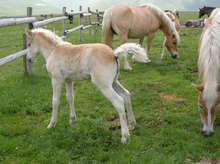As temperatures rise and rainfall and other wet conditions develop in many areas, horses that are pastured or maintained in areas where the ground is often wet may develop the condition Dermatophilosis also known as rain scald.

Environmental conditions condusive to rain scald
Rain scald is most prevalent in horses that are very young, very old, immunosuppressed or chronically exposed to moisture.
While many horse owners think the bacteria that causes Dermatophilosis lives in the soil, it is actually carried on a horse's skin. Some horses become immune to the bacteria, but others are affected year after year, usually during a warm, wet season, although the condition can occur during wet winter weather.
Two conditions must be present for Dematophilosis to develop:
- Wet weather
- A break in the skin of the horse
Rain scald is most prevalent in horses that are very young, very old, immunosuppressed or chronically exposed to moisture. Biting insects or infected tack, brushes or blankets may spread the infection from horse to horse.
The bacteria can live on damp fence posts, stall doors and other places where horses often rub themselves. If a horse is a carrier of the dermatophilosis bacteria, another horse rubbing itself in the same spot may become infected if there is a break in the horse's skin.
Once the bacteria is under the skin of the horse, it produces thread-like tentacles that spread in many directions. The bacteria likes anaerobic conditions meaning that it thrives in an environment where the oxygen content is low or absent.
Once a horse contracts rain scald, the infection is responsive to a course of antibiotics, and topical agents work well on infected areas. Infected areas should be clipped out, and scabs softened and lifted off. If scabs are not easily removed, soak or shampoo until they soften and can be gently removed with a soft brush.
The best method of prevention of rain scald is keeping horses in dry conditions whenever possible including making sure stalls and bedding are dry. Careful grooming on a daily basis will also help prevent rain scald if attention is paid to any breaks in the horse's skin or any signs that an infection has occurred.
Learn more about Dermatophilosis or Rain Scald
